
"From Watching to Doing So why does it work? Because AR doesn't just put your brand in front of people, it puts them inside it. It gives them something to do, not just something to watch. People are trained to ignore traditional ads. Scroll past. Skip. Close. But with AR, there's no banner blindness. You're playing with it, showing your friends, making it your own. That's how you build a lasting memory, not just earn a fleeting impression."
"And we've seen it firsthand, too. For Red Lobster, we turned fans into walking, talking Cheddar Bay Biscuits. It wasn't just a visual gag; it tapped into one of the most beloved icons on their menu. Within days, the "Biscuit Head" effect was trending in TikTok's effects tab, generating more than 11,000 organic posts with zero paid promotion behind it. People didn't just see the brand-they lived it. That's the kind of cultural spark AR creates when it's woven into the idea from the start."
Augmented reality has often been dismissed as a gimmick and relegated to add-on status in marketing scopes. Meanwhile AR has been reshaping everyday culture through mobile and social experiences rather than headsets or distant tech. AR works by putting people inside a brand, creating interactive, shareable experiences that overcome banner blindness and passive ad avoidance. Major brands like Fenty Beauty, L'Oréal, e.l.f., Oakley and Warby Parker use AR for virtual try-ons and social sharing. Campaigns can trend organically: a Red Lobster “Biscuit Head” effect generated over 11,000 organic TikTok posts with no paid promotion. AR drives lasting memories when integrated from the start.
Read at Muse by Clios | Discover the latest creative marketing and advertising news. Muse by Clio is the premier news site covering creativity in advertising and beyond.
Unable to calculate read time
Collection
[
|
...
]